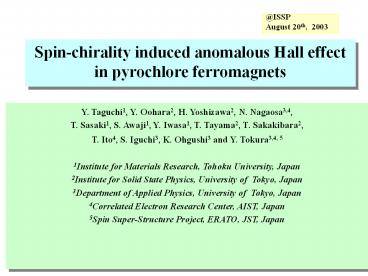Spin-chirality induced anomalous Hall effect in pyrochlore ferromagnets - PowerPoint PPT Presentation
Title:
Spin-chirality induced anomalous Hall effect in pyrochlore ferromagnets
Description:
1Institute for Materials Research, Tohoku University, Japan ... (111)-plane is Kagome lattice. 1. Introduction. M. J. Harris et al., Phys. Rev. Lett. ... – PowerPoint PPT presentation
Number of Views:82
Avg rating:3.0/5.0
Title: Spin-chirality induced anomalous Hall effect in pyrochlore ferromagnets
1
Spin-chirality induced anomalous Hall effect in
pyrochlore ferromagnets
_at_ISSP August 20th, 2003
Y. Taguchi1, Y. Oohara2, H. Yoshizawa2, N.
Nagaosa3,4, T. Sasaki1, S. Awaji1, Y. Iwasa1, T.
Tayama2, T. Sakakibara2, T. Ito4, S. Iguchi3, K.
Ohgushi3 and Y. Tokura3,4, 5 1Institute
for Materials Research, Tohoku University,
Japan 2Institute for Solid State Physics,
University of Tokyo, Japan 3Department of
Applied Physics, University of Tokyo,
Japan 4Correlated Electron Research Center, AIST,
Japan 5Spin Super-Structure Project, ERATO, JST,
Japan
2
Contents
- Introduction of R2Mo2O7
- Anomalous temperature dependence of sxy in
Nd2Mo2O7 - Sign reversal of rH in Nd2Mo2O7
- Sensitive dependence of sxy on the band-filling
in (Sm1-xCax) 2Mo2O7 - Summary
3
1. Introduction
Pyrochlore-type structure R2 Mo2 O7
Mo-sublattice, composed of corner-sharing
teterahedra.
(111)-plane is Kagome lattice.
Mo
R
4
Geometrical frustration in pyrochlore lattice
F-coupled spin system with strong single-ion
anisotropy
AF-coupled spin system
Spin Ice
Spin glass
M. J. Harris et al., Phys. Rev. Lett. 79, 2554
(1997) A. P. Ramirez et al., Nature 399, 333
(1999)
5
Electron configuration
Mo4 4d2
Mo ion is basically coordinated octahedrally by O
ions, but the site-symmetry is D3d .
6
Phase diagram
Mo4 4d 2 (constant filling)
7
Electronic structure
small Drude weight in Sm2Mo2O7 even in the
ground state.
Mott-Hubbard type (as opposed to CT type)
8
2. Anomalous temperature dependence of sxy in
Nd2Mo2O7
Anisotropy of Nd moments is transmitted to Mo
spins via the f-d interaction.
Strong single-ion anisotropy in Nd - moment
two-in, two-out
Nd 4f
Nd
Jfd
Mo
9
Resistivity, magnetization, and neutron
diffraction
10
Magnetic Structure determined by the neutron
diffraction experiment
umbrella structure
Nd 4f
at 8 K qN 7080 mN 2.2mB qMlt 10 mM
1.4mB
at 40 K( T) mN0.2mB mM1.3mB
A magnetic unit cell contains four Nd-moments and
four Mo-spins.
Mo 4d
11
anomalous Hall effect in magnetic metals
rH
rH Ey/jx RoH 4pRsM RoH ordinary term
(proportional to H) 4pRsM anomalous term
(proportional to M)
12
rH RoH 4pRsM
ordinary term anomalous term
13
low temperature data down to 0.5 K
Saturation of rH is observed only below 2 or 1.5
K.
14
Anomalous T-dependence of transverse
conductivitysxy rH / (rxx2rH2)
sxy for every direction continues to increase
down to 2 K.
Y. Taguchi, Y. Oohara, H. Yoshizawa, N. Nagaosa,
and Y. Tokura, Science 291, 2573 (2001)
15
Existing theories for anomalous Hall effect
Karplus and Luttinger, Phys. Rev. 95 (1954)
1154 L-S coupling of itinerant electron and
imbalance of up- and down-spin electron
Rs ? r2
J. Kondo, Prog. Theoret. Phys. 27 (1962)
772 interaction between conduction electron and
localized moment rH ?lt(m -ltmgt)3gt
16
Experimental results for other ferromagnetic
metals
Fe
La1-xCaxMnO3
C. H. Chun, M. B. Salamon, Y.Tomioka, and Y.
Tokura, Phys. Rev. B 61, R9225 (2000)
P. Matl et al., Phys. Rev. B 57, 10248 (1998)
17
Berry phase theory of anomalous Hall effect
J. Ye, Y. B. Kim, A. J. Millis, B. I. Shiraiman,
P. Majumdar, and Z. Tesanovic, Phys. Rev. Lett.
83, (1999) 3737
K. Ohgushi, S. Murakami, and N. Nagaosa, Phys.
Rev. B 62, (2000) R6065
Carrier moving in a spin background with strong
Hund's rule coupling JH t
JH
Si
Sj
tij t0 cos(qij /2) exp(i aij)
18
Theoretical calculation based upon the Berry
phase scenario
Experimental result is reproduced with Mo-spin
tilting angle of 4 - 5 degree.
19
3. Sign reversal of rxy
Prediction by the Berry phase theory
High-field measurements
Hall effect up to 27 T at 1.6
K Magnetization up to 23 T at 1.7 K,
Vibrating-Sample Magnetometer
High magnetic-field was provided
by a hybrid magnet _at_ IMR,
Tohoku University.
Low-T measurements
Magnetization down to 50 mK for H lt 12 T
_at_ISSP, Univ. of Tokyo
20
Field-dependence of rH and M for H 100 and
110
Magnetization
T-independent below 1.7 K
gradual magnetization process
Hall effect
rH monotonously approaches zero .
c.f. T. Kageyama et al.JPSJ 70, 3006 (2001)
21
Field-dependence of rH and M for H 111
Magnetization
T-independent below 1.7 K
Mo
gradual magnetization process c.f. Dy2Ti2O7
Hall effect
rH changes its sign at 7.5 T in accord with the
prediction.
22
Field dependence of Spin Chirality
H 100
Low Field
High Field
23
Field dependence of Spin Chirality
H 111
Low Field
High Field
24
4. Sensitive dependence of transverse
conductivity on the band-filling in
(Sm1-xCax)2Mo2O7
anomalous Hall effect in (Sm0.9A0.1)2Mo2O7 A
Ca2, Y3
In both cases, rxx and M show little
variation. In case of A Ca, sxy shows large
variation. In case of A Y, sxy shows little
variation.
role of Ca-doping
to introduce scattering center to partially
remove f-d interaction (Ca2 is non-magnetic )
to change the band-filling
Important !
25
rxx and magnetization
26
sxy is enhanced by as large as 800 !
27
Explanation based upon the Berry phase mechanism
M. Onoda and N. Nagaosa, J. Phys. Soc. Jpn. 71,
19 (2002).
Fermi distribution func.
ky
kx
gauge flux density
Gauge flux density exhibits sharp peaks at band
crossing points. As a result, sxy sensitively
depends on the position of chemical potential.
28
Summary
The sxy in Nd2Mo2O7 continuously increases down
to 2 K.
The rH in Nd2Mo2O7 changed its sign when the
field was applied along 111 direction while it
monotonously approached zero when applied along
100 and 110 direction.
The sxy in (Sm1-xCax)2Mo2O7 shows large variation
with the change of band-filling in spite of
little change of sxy and M.
These results suggest that the transverse
conductivity in these compounds are induced by
the spin chirality.

